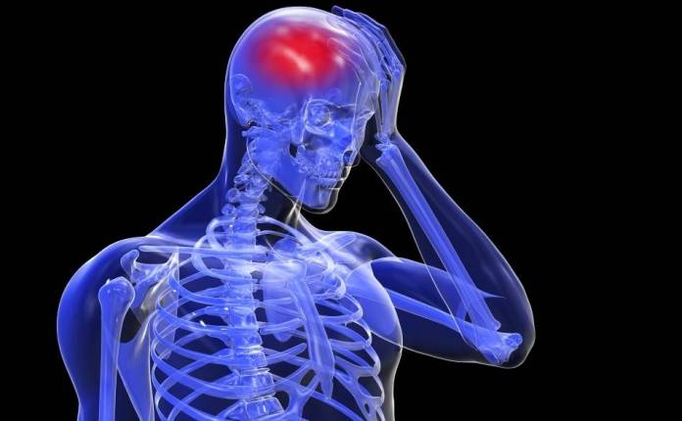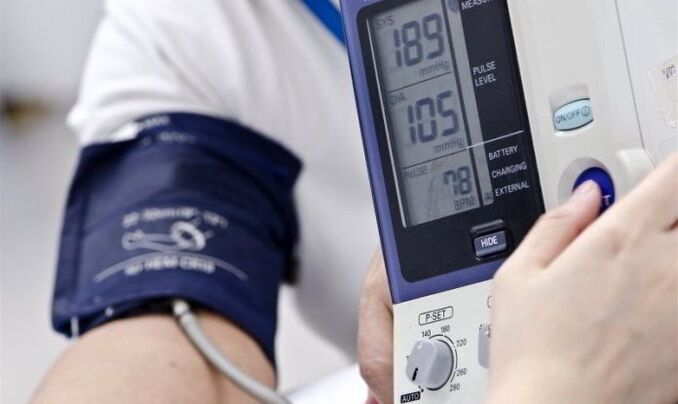Cervical osteochondrosis is a spine disease, which is characterized by intervertebral disc disorders.The pathology is characteristic of the elderly, but a person of any age can find it.Tangible discomfort causes one of the main signs of this disease: severe pain.The patient needs to know what cervical osteochondrosis is dangerous and what problems will have to face.
The details of the disease
The cervical region is one of the most mobile parts of the body, and finds regular loads.With the development of osteochondrosis, the change of vertebrae, which leads to the compression of numerous glasses and nerves.The main complexity of the pathology is that its characteristic distribution changes affect the roots of the spinal nerve and the intervertebral space discs.Because of this, the brain remains without the necessary oxygen, the blood supply is lost.

In the risk zone, there are mainly older people in which the disease develops in the context of metabolic disorders, and changes in the structure of vertebrae and intervertebral discs are related to age.The reason for the development of such violations can also be:
- salt deposition;
- insufficient physical activity;
- incorrect nutrition;
- wounds;
- frequent hypothermia;
- Hormone problems;
- Overweight;
- Chronic diseases.
Osteochondrosis also causes a long -term presence of the body in a position, which places the employees and drivers of the office under the blow of.
Symptoms of osteochondrosis
In the initial stage of the disease, the symptoms are almost invisible, anxiety can only cause mild pain in the neck.But as the pathology develops, the symptoms are gradually increasing.
The osteochondrosis of the cervical column can be identified by the following signs:
- Severe pain in the neck, neck, shoulders;
- regular migraines;
- Hand weakness;
- Neck mobility is limited;
- When turning the head, the vertebrae are crunch;
- Hearing problems;
- A characteristic bell appears in the ears;
- Throat haught.
In the initial stages, pain syndrome manifests itself only during movement, when the neck is tilted or turned.Over time, pain occurs even when the position of the hands changes.
Possible complications
If cervical osteochondrosis is not treated, degenerative processes in intervertebral discs will lead to the loss of their main functions and a decrease in density.Excessive column mobility will gradually develop, muscles, joints and ligaments will suffer.The pressure on nerve endings and spinal cord will only intensify, which will lead to an increase in symptoms and the development of new pathological phenomena.

Frequent migraines
To the most common consequences of the osteochondrosis of the cervical column, you can calculate a headache.This happens because it is in this site that the vertebral artery is located, which is responsible for the supply of oxygen and blood to the brain.
As the strength of the album changes, the amortizing functions are violated.The deformed vertebrae presses the artery, interfering with the blood circulation and the "supply" of the necessary oxygen.Muscle cramps are developing.
After pain, concomitant symptoms often follow:
- nausea;
- vomit;
- strong increase in pressure;
- tingling in the shoulder blades;
- Weakness throughout the body.
With severe attacks, it is desirable to relax as much as possible, it is better in a horizontal position.An unpleasant syndrome can remove analgesics or cold compresses, while the massage is useless.
Vision problems
The complications of cervical osteochondrosis often affect the vision organs: in this section of the spine there are sominal and vertebral arteries, which are responsible for the blood flow towards the central visual structure.The compression of nerve roots and blood vessels leads to hypoxia and causes a decrease in vision.
Together with vertebral artery syndrome, symptoms such as:
- fog;
- darkening in the eyes;
- the appearance of "flies" or colored points;
- fork;
- excessive optical nerve stress;
- dizziness;
- nausea.

During the exam, a specialist can notice a narrowing of the arterial vessels of the eye retina, there is less frequently swelling of the optical nerves.In addition, in the context of the disease, glaucoma may appear, accompanied by greater intraocular pressure and pain.
Hearing problems
Due to the compression of the vertebral artery and nerve roots, hearing loss is possible in 20-30%.Defendant cervical osteochondrosis can lead to even complete deafness.To avoid this, you must communicate with a doctor with the first symptoms of the disease.
A slight decrease in hearing is reversible: in addition to the pharmacological treatment prescribed by a doctor, the patient needs special exercises or massages of the hells of the ear.Watching television or listening to music is better in a small volume to tighten the auditory organs.
Hypotension or hypertension
Reduced or augmented blood pressure is quite common consequences of cervical osteochondrosis.The greatest danger is hypertension, which are characteristics:
- Pulse oomer;
- greater sensitivity to temperatures;
- sleep disturbances;
- nasal bleeding;
- dyspnoea;
- heart pain;
- Perspiration.
The higher the blood pressure, the greater the load on the heart, which leads to its rapid wear.As a result, heart failure is developed.In hypertension, atherosclerosis develops faster, which is dangerous with a stroke.
Hypotenia does not represent a direct threat to life, but greatly affects its quality.The body experiences oxygen hunger, which affects the patient's general well.Hypotonia is characterized by violations of the venous and arterial blood supply, and this implies alterations in the sensitivity of the extremities.Among the possible complications are myocardial infarction.

Vegetos -Vascular Distonia
Vegetables: vascular dystonia is a general designation of the syndrome, which can affect several body systems and organs.Most of the pathology, the cardiovascular system and peripheral nerves suffer from pathology.The patient experiences constant anxiety and strong emotional differences.Frequent panic attacks are also possible, and heart rate becomes more frequent.
Symptoms of dystonia can lubricate or disguise themselves like other diseases.The consequences of the osteochondrosis of the cervical region in this case are not the most pleasant.Then, the gastrointestinal tract often suffers: nausea and vomiting, diarrhea, constipation and severe abdominal pain.Biliary or liver disorders are possible.Patients often complain about tachycardia, pressure problems and cardiac pain.
Intervertebral hernias
With an intervertebral hernia, the fragments of the album are "standing out" on the spinal channel or fall.The initial stage of this pathology is called protrusion.The integrity of the intervertebral disk is not disturbed with him, but there is a slight bone protuberance into the spinal channel.At this stage, the pressure on the roots of the spinal cord, so the main symptom is the weak pain that occurs during movement.In the posterior stages, pain syndrome is improved.
The mobility of the vertebrae is gradually reduced.Muscle tension is improved, even if the patient seems to be in a relaxed state.You can also observe periodic weakness in the upper parts of the hands or dolls.The numbness appears, and a tingling tingling often occurs near the thumb.
This is what is the dangerous osteochondrosis of the cervical column with hernia: it has a serious load in the artery, which passes next to the spine and is necessary for the proper blood supply to the brain.If excessive patient pressure occurs, an ischemic stroke can be expected.
A large hernia is dangerous for the inflammation of the surrounding ligaments: it is loaded with cervical radiculitis.Only timely treatment can prevent complications.The patient needs to listen carefully to his body and in the first symptoms see a doctor.Suspicions should cause:
- acute attacks of nausea without visible reasons;
- Dark in the eyes when it moves;
- noise in the ears when turning the head;
- Throw sensations on the neck with a long stay in standing position.
The most serious complications are the risk of irreversible paralysis of one or both hands.The atrophy of the brain nerve leads to this, which is found in the cervical region.If the hernia begins to exert pressure on the blood vessels, they will gradually die, which will lead to an innervation of several organs.
Vestibular barrel syndrome
Vestibular barrel syndrome is a condition in which the patient experiences strong dizziness that accompanies the loss of guidance.
The attacks arise with a strong increase, turning fast or throwing their heads back.State characteristic:
- noise in the ears;
- nausea;
- visual disability;
- The feeling that everything turns and floats before his eyes.
The main reason for the pathology is the lack of blood supply, which implied the dysfunction of the vestibular device.The syndrome will occur more and more as the osteochondrosis develops.
Glorious minute syndrome
Osteochondrosis launched is dangerous with neurovascular throat and larynx disorders.The syndrome is characterized by:
- hoarseness;
- difficulties when swallowing;
- constant sensation of a coma in the throat;
- dryness and pain;
- Complete voice loss.
The syndrome occurs suddenly and is accompanied by dizziness.
Syndrome Bar Liek
The second name of the pathology is the vertebral artery syndrome.The reason for its development is the stenosis (narrowing) of the vertebral channel, in which spasms of the vertebral artery and the compression of the blood vessels and the nerves are produced.
Symptoms include:
- hypertension;
- nausea;
- tachycardia;
- Carving in the eyes;
- noise in the ears;
- loss of movement coordination;
- Pulsing pain in the temples or in the occipital region.
With an acute movement or turning the neck, the patient can lose knowledge.

Hypotolamic syndrome
At the same time, the hypothalamus suffers from the syndrome, a part of the brain that is responsible for metabolism, pressure, sleep, body temperature and emotional reactions of a person.Functional disorders can manifest improving or weakening the activity of the department of the brain.In the first case, the patient becomes irritable, in the second inhibited.
Symptoms often resemble neurasthenia, which manifests through:
- Sleep disorders;
- resentment;
- irritability;
- high fatigue;
- Instability of mood.
A person loses the opportunity to concentrate, there are problems with memorization.Irazonable outbreaks of anger are possible, the appetite disappears, the libido decreases.
It is better to prevent any disease to treat, predicting the behavior of osteochondrosis is quite difficult.If there are risk factors, you must regularly perform a set of simple physical exercises that will increase the mobility of the vertebrae and eliminate congestion in the necklace area.
The frequent appearance of any of the symptoms described is the obvious signal of the body about the problems that occur in it.At the same time, the car -medical is useless, and without consulting a specialist will not work.



















































